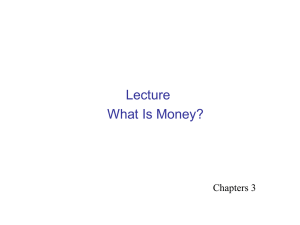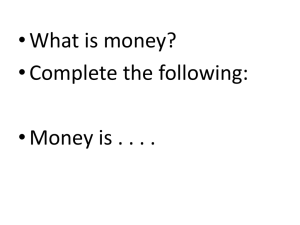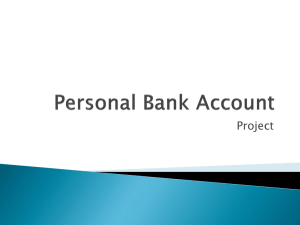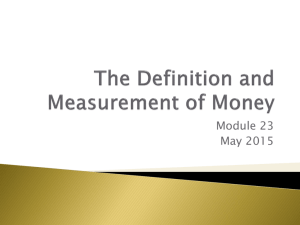Chapter 31: Money, its Nature and Functions What is Money?
advertisement
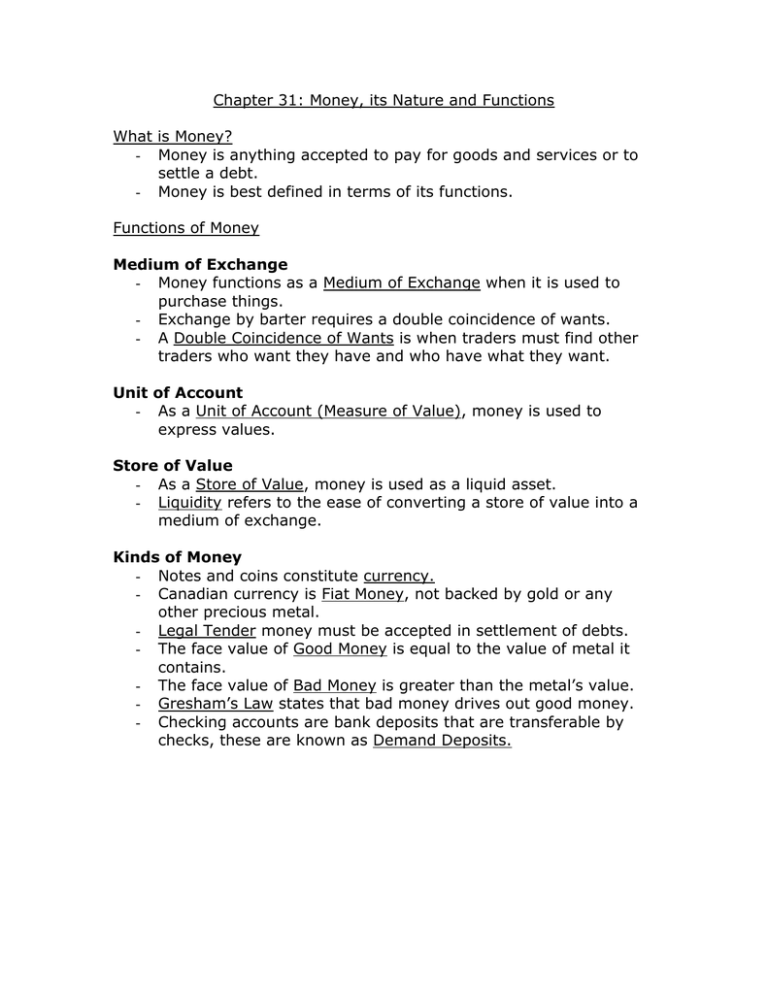
Chapter 31: Money, its Nature and Functions What is Money? - Money is anything accepted to pay for goods and services or to settle a debt. - Money is best defined in terms of its functions. Functions of Money Medium of Exchange - Money functions as a Medium of Exchange when it is used to purchase things. - Exchange by barter requires a double coincidence of wants. - A Double Coincidence of Wants is when traders must find other traders who want they have and who have what they want. Unit of Account - As a Unit of Account (Measure of Value), money is used to express values. Store of Value - As a Store of Value, money is used as a liquid asset. - Liquidity refers to the ease of converting a store of value into a medium of exchange. Kinds of Money - Notes and coins constitute currency. - Canadian currency is Fiat Money, not backed by gold or any other precious metal. - Legal Tender money must be accepted in settlement of debts. - The face value of Good Money is equal to the value of metal it contains. - The face value of Bad Money is greater than the metal’s value. - Gresham’s Law states that bad money drives out good money. - Checking accounts are bank deposits that are transferable by checks, these are known as Demand Deposits. Near Money and Money Substitutes Near Money - Notice Deposits are interest-earning deposits subject to notice before withdrawal. - Near Money is any highly liquid asset that can be easily converted into currency or demand deposits without much loss of value. Money Substitutes - Credit cards are not money; they are money substitutes. - The use of money in transactions discharges debts, but the use of credit cards establishes debts that must ultimately be discharged by using money. The Money Supply in Canada - The narrow definition of Money (M1) emphasizes the medium of exchange function. - Border definitions of money (such as M1A) include notice deposits and other highly liquid assets. o M1 = Currency outside banks + demand deposits in chartered banks – private sector float. o M1A = M1 + daily interest checkable and non-personal notice deposits. o M2 = M1A + other notice deposits + personal term deposits o M2+ = M2 + deposits at trust and mortgage loan companies + deposits and chares at caisses populaires and credit unions. o M3 = M2 + other non-personal fixed-term deposits + foreign currency deposits of residents of Canada. - Demand deposits are the most important type of money in Canada The Canadian Payments System - The Canadian Payments System has evolved from using a very simple system using commodity money to a highly sophisticated system using electronic devices. The Present Payments System - The Canadian Payments Association facilitates transfers between financial institutions. The Payments System of the Future - The Electronic funds transfer system (EFTS) funds instantly between accounts. - The use of Debit Cards (Payment Cards) permits the instantaneous transfer of purchasing power. The Value of Money - The Value of money is inversely related to the price level. The Money Supply and Inflation - Excessive increases in the money supply are inflationary. - Continuous increases in the money supply at a tremendously rapid rate will result in severe inflation. The Money Supply and Unemployment - Inadequate growth in the money supply can cause unemployment. - Reductions or inadequate increases in the money supply may result in economic slowdowns and increases in unemployment.



